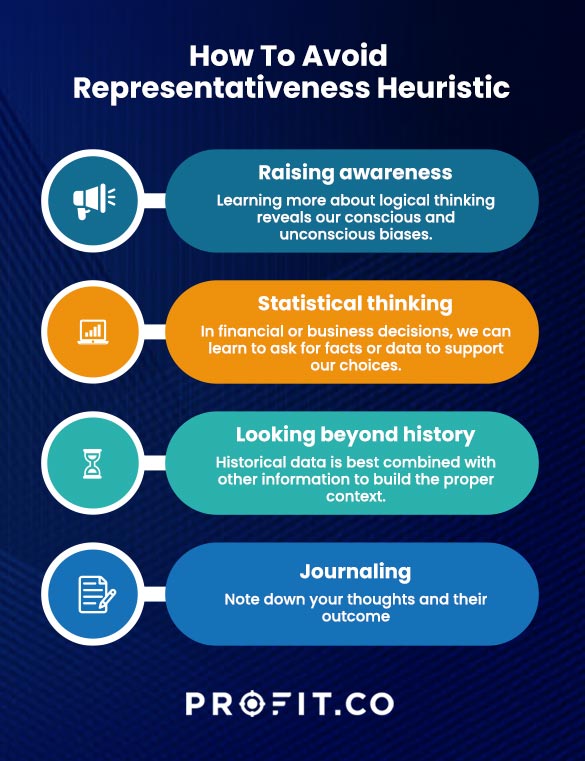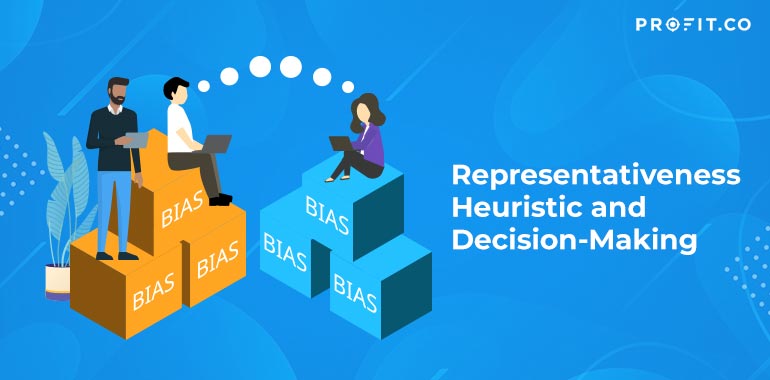Decision-making is a complex process that determines our daily lives, from choosing our meals, our significant others, our purchases, and our investments. But the human brain, remarkable as it is, often takes shortcuts to help us make decisions.
One of these mental shortcuts is called a representative heuristic. Let’s begin by defining some essential terms to understand what representative heuristic means.
What Is A Bias?
A bias is a thinking pattern for or against a person, group, object, or idea. Biases are learned from an early age and are generally unconscious to us, making them difficult to identify and correct. Preferences form the basis of stereotypes about gender, race, religion, nationality, occupation, age, or disability.
Example: A marketing strategy may rely on stereotypes to build audience personas. They inadvertently leave out customers that don’t fit their descriptions, therefore losing lead generation opportunities.
What Is A Heuristic?
A heuristic is a general formula or commonsense rule used as a shortcut to problem-solving. It relies on the information you already know to guesstimate an unknown outcome. Heuristics are easy ways to save time on decision-making, especially if we need more time for a thorough situational analysis. Heuristic decision making more often causes more errors of judgment than rational decision making based on data.
Example: A company may rely on heuristics during recruitment, which is usually a complex, drawn-out process. A manager may disqualify every job application with a typo based on the heuristic that if an applicant can’t catch spelling errors, they lack the attention to detail that the job requires.
What Is Availability Heuristic?
The availability heuristic is how recent events influence our decisions about the present and future. If something happens recently, we tend to believe it will happen again regardless of its actual probability. The availability heuristic depends on what we see and remember quickly.
Example: A business may resist digital transformation because its old systems still work fine. Transitioning to cloud-based systems is unknown, and the company would instead stick to what they know and use daily. Management makes this decision despite the competitors making successful digital transformations.
Book a free demo with our team to learn more about how OKR software can optimize your organization’s performance by improving decision making and helping focus and achieve goals.
What Is Representativeness Heuristic?
The representativeness heuristic is a bias that makes us believe that a stereotype is true. It’s a mental shortcut that helps us group the world into simple categories like X and Y. Suppose we encounter a new experience or data. In that case, we determine if it’s similar or representative of X or Y, and we rarely consider that it could be an entirely new category Z.
Here’s a representative heuristic example in business: an entrepreneur may choose the easy route and copy other successful companies in product packaging and advertising. The better approach is conducting thorough research to understand the market and reveal new opportunities.
Note: There’s a difference between the availability heuristic vs the representative heuristic. The availability heuristic makes assumptions based on recent information or events because it makes a fresh or lasting impression on the mind. Representative heuristic makes assumptions based on superficial similarities or patterns in events, whether recent or dated.
Prejudice is a burden that confuses the past, threatens the future and renders the present inaccessible.
Why Does Representativeness Heuristic Happen?
Just like all biases, representativeness bias is natural to humans. One typical example is when children learn to speak and identify a four-legged furry animal as a cat when the animal is a dog. The confusion is because both have four legs and tails and can be broadly categorized as similar. The representativeness heuristic occurs for the following reasons:
- More Efficient
We often need more time and energy to study all the statistics around an event, so we opt to see similarities rather than probabilities. This typically leads to poor decision-making and errors in judgment.
- Follows Categories
We naturally group similar things and give each group a prototype to represent it. These prototypes help us to navigate life as we compare and connect new experiences to the tried-and-true.
- Follows Patterns
We’re biased toward events that resemble each other, whether experienced firsthand or through others. A previous or recent event is more likely to happen again, whether or not it’s statistically possible. These similarities in representativeness are more valuable than different occurrences.
- Disregards Sample Size
We intuitively go for probability ratios that agree with our stereotypes or mental prototypes rather than the actual sample size. When the proportion of representative characteristics is higher, we view it as an accurate sample and thus become falsely confident in our choice.

How To Avoid Representativeness Heuristic
It’s challenging to eliminate the representative heuristic bias because it’s a natural part of our mental wiring. Instead, there are some strategies we can use to avoid its negative impact on decision-making. These include:
- Raising awareness of biases: Learning more about logical thinking reveals our conscious and unconscious biases. The easier we can identify them, the better we avoid their influence.
- Statistical thinking: In financial or business decisions, we can learn to ask for facts or data to support our choices. While data can help avoid Representativeness Heuristics we must be careful to avoid confirmation bias as well by not cherry picking data that suits our bias.
- We can also hire investment or business development consultants for expert guidance instead of relying on our biases.
- Looking beyond history: While the past is a typical basis for forecasting, it only gives us a partial picture. Historical data is best combined with other information to build the proper context. Hindsight bias should be avoided when we look at past data and events.
- Journaling: If you need to make an important decision, note your thoughts about it and its outcome. Over time, you’ll identify biases in your reasoning and learn to open your mind to greater possibilities.
In conclusion,
The representativeness heuristic bias is an instinctive mental shortcut that sways our decision-making process. It’s also related to confirmation bias and availability heuristics, which affect how we view the world. Representativeness bias is challenging to spot and avoid, but greater awareness of our mental processes can help to overcome it. Profit.co is a very flexible product and supports focus and achieving goals. Most organizations need to manage representativeness heuristic bias in focused decision making. You can get started on Profit.co completely free today to help set the right tone for your organization.

